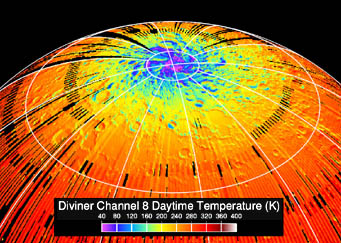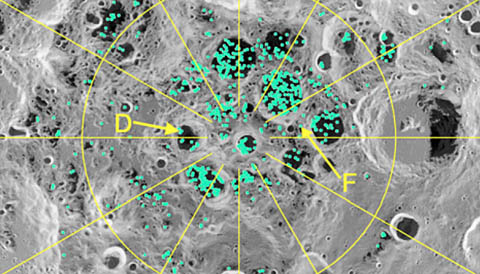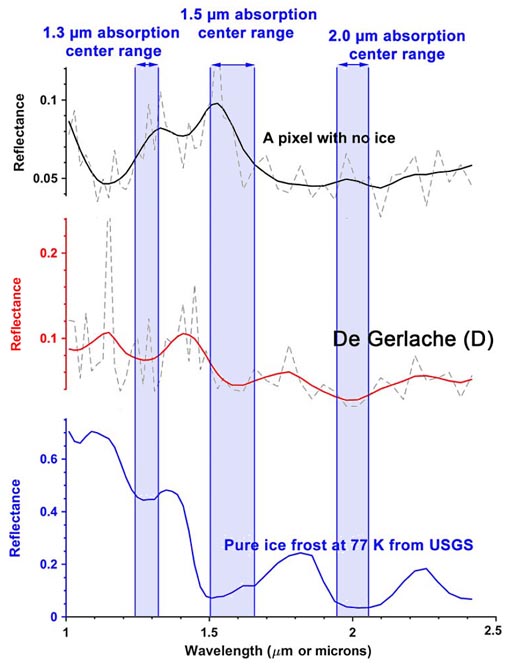After more than a decade of tantalizing but inconclusive hints, new research shows convincingly that patches of water ice lie exposed on the floors of many permanently shadowed lunar craters.
The quest to find water on the Moon is a scientific pendulum that has swung widely over the centuries. Long ago we used "seas" to denote the Moon's dark, roughly circular areas, believing them to be reflections of Earth's oceans. The telescope changed that fanciful notion, and then our thinking was totally reset when the first Apollo samples proved bone dry and lacked any minerals consistent with a moist Moon. Another return swing occurred when reanalysis of Apollo samples found substantial amounts water trapped in tiny beads of volcanic glass.
The pendulum now seems firmly pinned to the "yes, there's water" extreme with a research report authored by Shuai Li (University of Hawai'i) and seven colleagues in August 20th's Proceedings of the National Academy of Sciences. They used near-infrared spectra from an instrument on India's Chandrayaan 1 orbiter to provide strong, unambiguous evidence for deposits of exposed water ice in permanently shadowed craters at the lunar poles.

NASA / Diviner team
Water ice can remain inside these craters because their floors are never exposed to direct sunlight, the consequence of a lunar spin axis that's nearly (within 1½°) perpendicular to the ecliptic plane. Temperatures at these always-dark crater floors are extremely low, plunging to as low as 40K (–390°F) inside some of them. Any local traces of water vapor — delivered, say, by a small comet's impact — will freeze out at these "cold traps" and remain there.
Earlier observations had argued for water deposits inside these craters, but the evidence was indirect. For example, as early as 1994, radar pulses fired from the orbiting Clementine spacecraft and recorded on Earth after bouncing off the Moon revealed some polar craters that reflect the radio energy strongly, suggestive of water ice sequestered on their always-dark floors. More recently, cleverly obtained images from lunar-orbiting spacecraft show that the polar craters' shadowed floors are relatively bright at ultraviolet and near-infrared wavelengths, but being "bright" doesn't automatically mean "due to ice" — other explanations are possible.
Here's another smoking gun: An instrument on NASA's Lunar Reconnaissance Orbiter has counted neutrons in a specific energy range emitted from the lunar poles that must have interacted with hydrogen atoms and thus, most likely, water. (Here's a 2-minute-long NASA video that explains this detection technique in more detail.)

Shaui Li et al. / PNAS / CC-BY-NC-ND 4.0
But the neutron-spectrometer work can't distinguish molecules of water (H2O) from its chemical relative hydroxyl (OH), which readily binds to rocky minerals. Also, the neutrons could be coming from the surface or from depths of up to a few tens of centimeters (up to 1 foot down).
The work of Li and his colleagues sidesteps all of these ambiguities by looking for three specific near-infrared absorptions — near 1.3, 1.5, and 2.0 microns — created by vibrations in water ice lying directly on the lunar surface. They carefully examined spectral maps made by the orbiter's Moon Mineralogy Mapper, or M3, and repeatedly found all three absorptions in the map pixels that corresponded to permanently shadowed crater floors at both lunar poles.

Shuai Li et al / PNAS / CC-BY-NC-ND 4.0
Modeling suggests that this three-band technique is sensitive enough to identify surface deposits containing as little as 2% to 5% water ice by weight. Moreover, the M3 spectra only signal the presence of water in craters poleward of latitude 70°, and 90% of the positive detections occur within 10° of each pole.
"I did not have any hope to see ice features when I started this project," Li explains in a press release from the University of Hawai'i. "I was astounded when I looked closer and found such meaningful spectral features in the measurements.”
He adds that understanding the processes that led to water ice on the Moon provides clues to understand the origin of water on Earth and throughout the solar system. And of course knowing that water ice lies exposed at the lunar poles is a big plus in the minds of those designing future lunar colonies.
 4
4
Comments
Bill -Simpson
August 24, 2018 at 11:19 pm
It is somewhat surprising how little attention this has gotten, since it is a game changer for possible Moon exploration and research. Water on the Moon means a lot less will need to be transported from Earth, which is a rather expensive process. Water on the Moon, a potential rocket fuel when broken down into oxygen and hydrogen using solar or nuclear power, combined with reusable rockets like the Falcon Heavy, and the coming New Glenn by Blue Origin, have the potential to significantly lower the cost of researchers living on the Moon for long periods. Having to transport everything to sustain life, combined with the cost of throwing away entire enormous rockets for every trip to the Moon, are what have kept people off the Moon for half a century since the 6 landings of the Apollo Program. And back then, all the money had to come out of taxpayer's pockets. Now we have self made billionaire space geeks to help pay for it. How cool is that. And they are employing thousands of people at high incomes. They pay a lot of taxes and spend a lot of money, creating more employment.
In less than 3 years, the Moon will be getting a lot of attention again. With scores of cable & satellite TV channels, you can expect a lot of live coverage of departures, landings, and walks on the Moon. No longer will the Moon have to interrupt the soaps or sitcoms to get on live TV. And we have the Internet everywhere now.
Since NASA will be involved, they might do a lot of live coverage on NASA TV & on their Internet site. Why not? They won't even need to hire another NASA employee to narrate anything. Just feed video from whatever cameras are up there. How cool would it be to be able to walk or drive around on the Moon on your big screen TV. It is the closest most people will ever get to it, unless they become an astronaut. That's rather tough. And let's face it, not too many people miss the Superbowl to watch NASA TV. For, 'LIVE from the Moon', I'll put NASA on one of my 3 TVs. I bet millions of foreigners would watch too, especially over the Internet.
You must be logged in to post a comment.
Peter Wilson
August 25, 2018 at 6:15 pm
There is water there, but not the gear you need to get at it. It's at the bottom of a cold, dark hole; out of radio-contact with Earth; and frozen hard-as-granite. The mining equipment needed to mine it has not been invented yet, because there is nothing comparable on Earth...especially the high-vacuum, 1/6th gravity, and dust. And once you get it, you need more gear to turn the water into wine--I mean--rocket-fuel. Like Biosphere II, the operation can be expected to be bedeviled by the unexpected. But if billionaire tech-geeks are willing to fund it, go for it!
You must be logged in to post a comment.
Lin4d
August 27, 2018 at 1:21 am
Gentlemen and Ladies: This isn’t 1918—it’s 2018! It would be an interplanetary crime to squander precious lunar water for use as chemical rocket fuel! Chemical reactions, such as combusting hydrogen in oxygen, produce, at most, only one or two volts of energy per reaction. China, India, Japan, and Russia have all announced plans to “colonize” the Moon in order to harvest 3He, AKA “the perfect fusion fuel from the lunar regolith. While the retro-USA is planning on pointlessly bringing back to Earth a rock from an uninteresting asteroid, a dead-end mission if there ever were one, China has established a “street price” for lunar 3He delivered on earth for about $4 billion per ton—in order to be competitive with one volt chemical fuels such as burning hydrogen in oxygen. When ignited in an “inertial confinement fusion” (ICF) reactor, the ICF reaction 3He + 3He + k (Boltzmann’s constant) T (= 3x108 K ignition temperature) → 4He + 2 1H + more than ten megavolts of energy per reaction, seven orders of magnitude higher than chemical fuels, gram for gram. 3He is not radioactive, and is currently relatively plentiful in the lunar regolith (thanks to the Moon's “spotty” localized magnetic fields). For billions of years now the Moon has had a monopoly on 3He in its regolith with Mercury (blessed with a very weak magnetic field) close behind. 3He is implanted by the Solar Wind in the lunar soil and simplifies things by being a homonuclear fusion fuel (unlike deuterium and tritium) which produce about 24 megavolts per fusion reaction while emitting a pesky 14.3 MeV neutron (which can make other things radioactive) and requiring that 6Li be used in the reactor wall in order to capture that neutron to breed an unstable 7Li nucleus which decays into 4He and a radioactive 3H (tritium) nucleus to replace each fused tritium nucleus. Using the 20 GW brute-force Prometheus-L (laser) or Prometheus-I (heavy ion) Fusion Test Reactors designed in 1992-4 by an aerospace team led by McDonnell-Douglas Aircraft Company, both ICF reactors in solar orbits and on the lunar surface could generate the necessary power to operate “rail-gun” technologies, as well as directed energy laser and heavy ion beams supplying power to launched outward bound spacecraft that wouldn’t need ancient “rockets.” Each spacecraft would need its own 3He ICF reactor to operate lasers and generate electricity. The absence of a significant lunar atmosphere is a huge advantage because it permits lunar-based directed energy machines to tap into GW levels of stationary fusion power plants on the Moon to fulfill many more missions that simply pushing spacecraft out of the Solar System. The nation that controls this technology on the Moon will control the Solar System from the orbit of Venus to that of Jupiter. This 3He ICF technology makes real estate on the Moon and on Mercury by far the most valuable in our planetary system. Mars’ thin atmosphere makes it impossible for the 3He in the Solar Wind to reach the Martian surface. 3He power plants built in orbit above Mars could used huge coils to create a mass-spectrometer to separate 3He ions out of the 4H3 and 1H ions in the Solar Wind. With a surface area greater than North and South America put together, powered with 3He fusion technology (supplemented by solar panels), using two billion year old cyanobacteria's photosynthetic capabilities, the O=C=O exhaled by lunar colonists enjoying the same "solar constant" available to Earth dwellers can be turned into sucrose, water, and oxygen with the necessary hydrogen being generated as an "ash" by the 3He fusion process. Using Siemens' technology, human waste can be turnedinto methane, combusted to form O=C=O gas to produce more food and more electricity. Using 3He as fusion fuel, electricity is generated not with an old fashioned heat exchanger, water boiler, steam driven dynamo needed for deuterium and tritium fusion power plants, but with simply passing the protons through a coil of wire since the 1H nuclei are electrically charged. Just think of the possibilities! If we develop 3D printers for human flesh, and, as in the film, "Contact, "SETI finds an advanced civilization orbiting a star ten light years away, it won't be necessary to use spacecraft at all to send "humans" to such planets with advanced life forms. We can just transmit the necessary data using a modulated laser beam to "3D print people" on an alien planet light years away with the "memories" needed to animate that "printed person" also being transmitted via laser. How about that?
You must be logged in to post a comment.
astromaster
August 25, 2018 at 11:01 am
Hi Bill: J. Kelly Beatty has started one of the discussions for our time. However, though you are accurate about some of the problems having been fixed you are missing one of the real problems. IOTA started its Lunar Meteor Watch program years ago and was ignored by all including NASA until regular impacts were observed (then NASA set up their Meteor Watch Program as if the idea was all from them). The NASA LADEE mission was sent to observe for dust (again an IOTA published issue from around 1990) and found that the dust was being caused primarily by meteor impacts. The next landings and a more permanent Lunar Base will be at the South Pole, but we are going to have to plan the base as a safe underground structure to have any real protection from Lunar Meteors. Water is important and a great discover, but it is not the only issue for a permanent Lunar Base. Just my two cents worth!
You must be logged in to post a comment.
You must be logged in to post a comment.